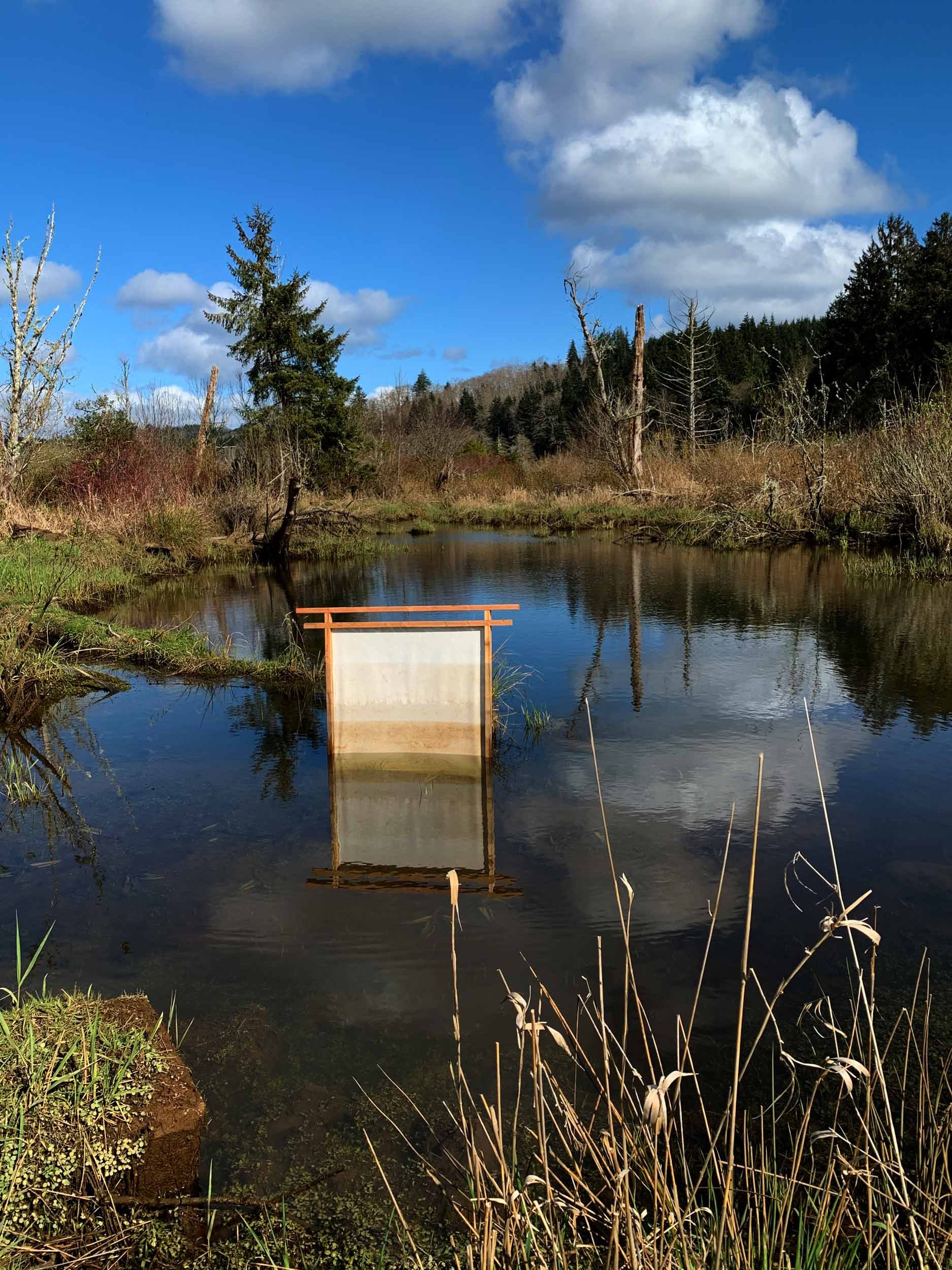PALUS
2021 collaboration with kerry davis
Palus (Latin, “swamp”) is a meditation on a Sitka spruce swamp along the Grays River, which flows into the Columbia River Estuary 20 miles east of the Pacific Ocean in Southwest Washington State.
Through outdoor installations and time-based processes, the project observes the tidal wetland’s liquid respiration and contemplates impermanence, both in methods and outcome. The multiple modalities used in the project are intended to reflect the dynamic, multilayered nature of the place. Many of the mediums use a hands-on approach; and the project foregrounds physical, tactile experience and the ideas of presence and immediacy.
The project was developed during a remote residency through Oxygen Art Centre, based in Nelson BC. The monograph booklet they produced can be purchased by contacting me or on the Centre’s site here.
torii tidal screens
The Torii Tidal Screens serve as focal points for daily observation, registering the varying levels of the tide as the swamp water marks the 4’ x 5’ canvases. Depending on placement, light and other conditions, the screens sometimes fleetingly reveal shadows cast by such things as shimmering water or plants growing out of floating logs. In form and function, the screens evoke Shinto gates which mark the transition from the mundane to the sacred. In this case, the two categories merge, with the oft-maligned or undervalued swamp metamorphosing into a vital natural space worthy of admiration.
swamp cinema shadow screens
For the Swamp Cinema Shadow Screens, we let the swamp project its own film on rare sunny mornings without fog. The variously shaped screens define and spotlight the dense swamp vegetation. These images of lichen, red-osier dogwood, alder, fern and horsetail emerge as motifs throughout the project, echoed again in anthotypes and nature prints.
Palus prints
The Palus Prints employ the Gyotaku method by rubbing inked found flora and fauna onto Japanese papers.
Anthotypes
Red elderberry and horsetail on skunk cabbage emulsion
For the anthotypes, we’ve utilized plants from the swamp, both as medium (emulsion) and subject matter. We make photosensitive emulsion from skunk cabbage (aka swamp lanterns), salmonberries, red elderberries and blackberries. We create contact prints over hours in full sun of Spiraea Douglassi, willow and other native plants. The images will fade over time, especially if left in the light; and their fugitive nature reflects the changing water/landscape that constantly reshapes itself.
Left, Red osier dogwood branch on salmonberry emulsion. Right, Salmonberry branch on red elderberry emulsion.
Left, Alder and Douglas’ spirea branch on red elderberry emulsion. Right, Fern and willow on blackberry emulsion.
boundary ribbons
Over months of daily walks and observing the swamp from the vantage of a dike road, we’ve always been struck by the difference between the pasture on one side and the Sitka spruce swamp on the other. This one dike road encapsulates the entire area’s economic and land-use history of the last 150 years. After purchasing a defunct dairy farm, Columbia Land Trust was able to breach a nearby levee to restore a small part of swamp that was once the predominant ecosystem here. Wanting to symbolically reconnect the pasture and the reemergent swamp, we developed the Boundary Ribbons. Draped across the dike road, the Boundary Ribbons are 5’ wide x 60’ long strips of canvas that stitch together swamp and pasture. Vehicles, people and wildlife leave their traces, and the waters in the ditch and swamp wick up at each end. The ribbons evoke free flowing water as it breaches the levee and returns to the river’s historic surge plain.
Surge plain
The project culminates with the paired installation, Surge Plain. After months of replacing the swamp-stained canvases in the Torii tidal structure, we mounted 8 screens in simple frames and temporarily sited them in the pasture. Arranged in an undulating line, the grouping faces and dialogues with the Boundary Ribbons as well as the swamp beyond. Marking tide levels in a would-be surge plain, the screens’ collective palimpsest of layered indexing likewise chronicles half a year of flowing time.
acknowledgements and gratitude
We want to acknowledge that the Sitka spruce swamp featured in this project rests on the unceded lands of the The Chinook Nation. What we now call the Grays River and Wahkiakum County are the ancestral lands of the five westernmost Tribes of Chinookan peoples: the Lower Chinook, Clatsop, Willapa, Wahkiakum, Kathlamet and many other Tribes who made their homes along the lower Columbia River. As settlers and guests, we recognize the strong and diverse Native communities in our region today, from Tribes both local and distant, and offer respect and gratitude for their stewardship of these lands—past, present and future.
We also especially thank Oxygen Art Centre; Columbia Land Trust; and, for their contributions to the monograph booklet, Rachel Rosenfield Lafo, Andrew Emlen and Robert Michael Pyle.
Process
Having relocated in 2019 from Portland, Oregon to a rural hamlet on the Grays River, we are fortunate to live and work next to 55 acres of restored tidal wetland protected by the Columbia Land Trust. In a continuation of our work with the Columbia River, we see the project as a way to situate ourselves and our society within a historical and geological context, and deepen our intimacy with this riverine place ruled by tides.


































